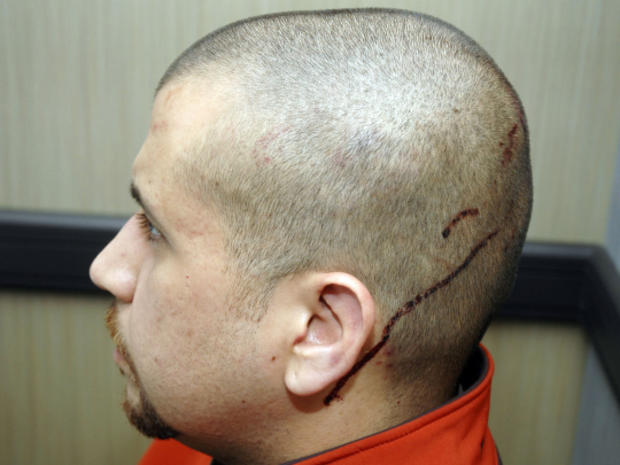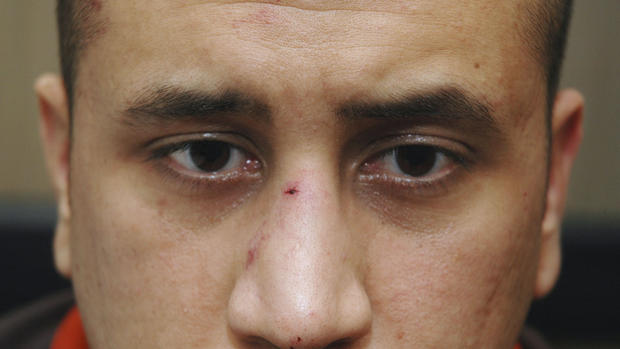Trayvon Martin Shooting: New evidence shows wounds on Zimmerman's head, THC found in Martin's body
(CBS/AP) ORLANDO, Fla. - Prosecutors released new evidence on Thursday that sheds light into the fight between George Zimmerman and Trayvon Martin that preceded Martin's shooting death.
Pictures: George Zimmerman's injuriesPictures: George Zimmerman charged with murder
According to CBS News, prosecutors released more than 180 pages of photos and eyewitness accounts in the case.
Among the evidence is surveillance video taken on the night of Feb., 26 at a 7-11 store in Sanford, where the the 17-year-old bought Skittles and a can of iced tea before heading back to the townhouse subdivision where he was staying with family. CBS News reports that this video is the last image captured of Martin, who was dead twenty minutes later.
A police report shows that Martin was shot once in the chest and pronounced dead at the scene. The autopsy revealed that the fatal shot was fired from no more than 18 inches away.
The 28-year-old Zimmerman has claimed self-defense and said he only fired because the unarmed teen attacked him. Zimmerman was not arrested for weeks because he invoked Florida's "stand your ground" law, which gives a person wide latitude to use deadly force rather than retreat if they believe they are in danger of being killed or seriously injured.
Although the original prosecutor in the case accepted Zimmerman's invocation of the law, a special prosecutor rejected his claim last month and charged Zimmerman with second-degree murder. Zimmerman pleaded not guilty. He was released on bail on April 23 and is reportedly in hiding.
Evidence supporting Zimmerman's defense includes a photo showing the former neighborhood watch volunteer with a bloody nose on the night of the shooting. A paramedic report said Zimmerman had a 1-inch laceration on his head and a forehead abrasion.
"Bleeding tenderness to his nose, and a small laceration to the back of his head. All injuries have minor bleeding," wrote paramedic Michael Brandy.
Christopher Serino, a Sanford Police Department investigator who called for Zimmerman's arrest, told prosecutors in a March 13 report that the fight could have been avoided if Zimmerman had remained in his vehicle and waited for authorities to arrive. He also said Zimmerman, after leaving the vehicle, could have identified himself to Martin as a concerned citizen and talked to him instead of confronting him.
Serino said there was no evidence Martin was involved in any criminal activity as he walked from a convenience store to the home of his father's fiance in the same gated community where Zimmerman lived.
Included in the evidence are also 911 calls made by residents of the community during the fight, although it is still unclear whose voice is heard screaming for help on the tapes. Martin's mother, Sybrina Martin, has said she believes the voice is her son's. While George Zimmerman's father told investigators that it was definitely his son yelling for help.
"That is absolutely positively George Zimmerman," Robert Zimmerman said, according to The Associated Press. "He was not just yelling, he sounded like he was screaming for his life."
Although the investigators sent all recordings to the FBI for analysis, the sound quality was too poor to determine who was doing the screaming.
Autopsy reports said medical examiners found THC, the psychoactive ingredient in marijuana, when they tested Martin's blood and urine.
But Larry Kobilinsky, professor of forensic science at John Jay College of Criminal Justice in New York, told the AP that the THC amount was so low that it may have been ingested days earlier and played no role in Martin's behavior. He doubts the judge will even let it be used by the defense if they try to introduce it at trial.
"This kind of level can be seen days after somebody smokes," Kobilinsky told CBS News. "If it comes up in the case, I would be surprised. It wouldn't benefit the defense, it wouldn't benefit the prosecution, and if the defense tried to bring it up, the judge would keep it out."
Among the newly released evidence are police interviews with coworkers and acquaintances who claimed Zimmerman made racist remarks and had a confrontational personality. Zimmerman's parents have disagreed with these characterizations, particularly the notion that their son is racist, saying that he had mentored black students and had a black relative, reported the AP.
Joelle Moreno, a Florida International University law school professor, said the evidence now released makes it difficult to predict if a "stand your ground" defense will work. Moreno is also a member of a state senator's task force examining the law.
Koblinsky, on the other hand, said that after reviewing the evidence he thinks Zimmerman is in a good position.
"I think the prosecution's case has been seriously diminished by all of this evidence," he said.
Complete coverage of the Trayvon Martin case on CBS News

